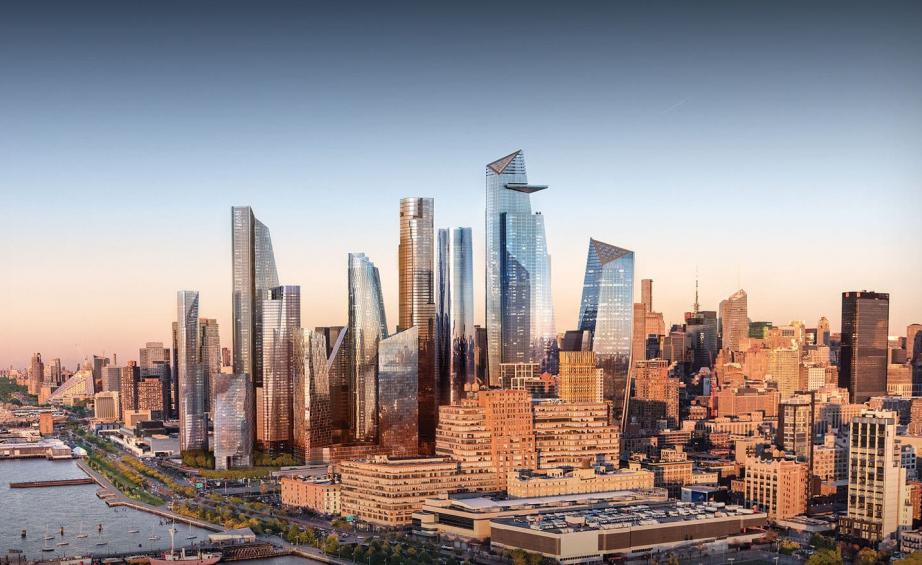Hudson Yards: breaking down New York’s new neighbourhood
wallpaper
You might have spotted it peeping over the High Line: a forest of cranes and lorries building out from Chelsea into the Hudson River. New York’s largest infrastructure project since the Rockefeller Center, Hudson Yards replaces a swath of decommissioned railyard – once nicknamed Death Avenue for the locals who wandered in the path of speeding trains. Today Hudson Yards is talked about in swirls of superlatives: a $25 billion expansion of Midtown, it will offer two million square metres of space in some of the greenest towers on earth, amid 14 acres of gardens and plazas. But once the dust clears, what will that mean, exactly? We break it down. Ellen Himelfarb. Images courtesy of Related

Hudson Yards
Hudson Yards, viewed across the Hudson River, is New York’s largest infrastructure project since Rockefeller Center. A $25 billion expansion of Midtown that will offer 2m sq m of space, amid 14 acres of gardens and plazas.

10 and 30 Hudson Yards, by Kohn Pedersen Fox
Two flagship towers anchor the south end of Hudson Yards at 11th Avenue and 30th Street. Both appear to tilt away from the other, framing views into the quarter. No.10, already occupied by blue chip tenants like Coach and L’Oréal, tapers to a prism summit with access to the adjacent High Line below. A media and finance hub housing CNN and HBO, No.30 will be New York’s second-tallest tower when it opens in 2019. Both appear to tilt away from the other, framing views into the quarter.

Observation Deck at 30 Hudson Yards, by Kohn Pedersen Fox
Putting the Empire State Building to shame, 30 Hudson Yards is claiming the highest outdoor viewing deck in the Western Hemisphere, at 305 metres. Fitted with a portion of glass flooring, it cantilevers 20m from the 100th storey, wrapping around the building’s southeast corner. The building’s designer, Bill Pedersen, hired Italian steel company Cimolay for the execution.

15 Hudson Yards, by Diller, Scofidio + Renfro
Living here in the 21st century is what a penthouse on Central Park West was to the 20th. Starting with an angular base, Diller, Scofidio + Renfro designed this residential landmark to morph gently into a clover leaf with banks of curved glass at the upper levels to maximise views over the city. When flats went on sale three years ago, the 84th-floor penthouse was priced at nearly $14 million. A rooftop terrace for all residents sits just above.

50 Hudson Yards, by Foster + Partners
Expect a construction site at No.50 for the next few years, as workers complete the project’s most lavish corporate headquarters (for BlackRock investments), taking up 58 storeys and an entire block of 10th Avenue.

50 Hudson Yards, by Foster + Partners
Ultimately, it’ll gleam from a façade of white stone and, mostly, glass, with entries on all four sides and outdoor terraces at the base of each distinct block. This view shows the development from the new ‘Hudson Park Boulevard’.

55 Hudson Yards, by Kohn Pedersen Fox
A. Eugene Kohn designed the firm’s third tower on the Hudson Yards site, using flat cast-iron detailing in a stylised grid pattern across the glass curtain wall. Double-height terraces bring fresh air to the lower floors around the podium, culminating in a 360-degree terrace at the tenth level, overlooking the High Line.

The Shops and Restaurants at Hudson Yards, by Elkus Manfredi
A retail complex to rival Macy’s further east (both sit at 93,000 sq m), Elkus Manfredi’s mouthful of a mall devotes a floor to e-commerce, inviting Amazon and Warby Parker to join traditional brick-and-mortar boutiques. A glass atrium reaches beyond the fifth floor Neiman Marcus flagship, and the immersive art gallery Snark Park, designed by local practice Snarkitecture, takes over a chunk of the second floor, nicknamed The Floor of Discovery.

The Shed, by Diller, Scofidio + Renfro
The bijou cultural landmark of the site, The Shed will programme experimental art and performance in a flexible structure when it opens this spring. Its telescoping glass shell-on-wheels will slide outward on iron rails – a nod to the area’s industrial past – to cover (and heat) the adjacent piazza, doubling the exhibition space.

Public Square and Gardens, by Nelson Byrd Woltz
Thomas Woltz sees his five-acre perennial garden as filling an erstwhile void between the High Line and Hudson Park. Laid overtop still-active Amtrak lines, it incorporates 28,000 plants, including fruit trees, wildflowers and cold-weather bloomers like winterberry. Concrete pavers top a ‘soil sandwich’ that encourages drainage and root expansion. A fan-powered ventilation system underneath keeps roots from overheating.

Vessel, by Thomas Heatherwick
Hudson Yards’ most freely accessible project is also its most polarising. Incorporating 154 staircases ascending and descending to 80 platforms, it’s been positioned (at the centre of the scheme) as a new monument for Manhattan, akin to Lady Liberty. Yet it sits somewhere closer to Anish Kapoor’s ArcelorMittal Orbit in the public imagination. Looks aside, it provides a mile-long climb for visitors and a curiosity for those peering down from the adjacent towers. Rendering courtesy of Forbes Massie, Heatherwick Studio

One Hudson Yards, by Davis Brody Bond
At the southern gateway to Hudson Yards, No.1 will be one of the most exclusive rental buildings in the city, topped by a four-bedroom townhouse on the 31st floor. Yet its lower elevation and burnt-red brick curtain wall make it one of the warmest in the scheme.

One Hudson Yards, by Davis Brody Bond
Architect Steven Davis designed One Hudson Yards as three consecutive towers in one, narrowing to an acute angle in the bend of the High Line. Manhattan-based architect Andre Kikoski heads up the residential interiors of One Hudson Yards – pictured here a living and dining space with dual aspect



Leave a Reply